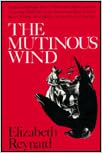|
Elizabeth Reynard, The Mutinous Wind (Parnassus, 1951) Black Sam Bellamy, a young and extremely successful pirate who plied his trade in the early 18th century, is the stuff good stories are made of -- up to and including his death when his ship, the former slaver Whydah, wrecked off the coast of Cape Cod in 1717.
The book is described on the cover as "A Tale of Old Cape Cod -- of Black Sam Belamy [sic] and his Pirate Ship WHIDAH [sic], of the mischievous Sand Dobbies, and of Mistress Maria Hallett, the Sea Witch of Eastham." Reynard, an English professor and Cape Cod enthusiast, gave Goody Hallett -- aka the Witch of Wellfleet, with whom Bellamy apparently had an affair -- the name Maria in her earlier book, The Narrow Land: Folk Chronicles of Old Cape Cod, and it has stuck, although scholars note there's no reason to believe that was her name; in fact, it would be an unlikely name in Puritan New England. This book doesn't really deal much with Bellamy's life or deeds. If you pick it up, as I did, expecting a ripping pirate yarn, it's not here. We meet him briefly as a young man, and we don't see him again until he's en route to Cape Cod on his final journey. We're told he's been quite successful as a pirate, but we're not given much evidence to quantify his successes. (According to his Wikipedia entry: "Though his known career as a pirate captain lasted little more than a year, he and his crew captured at least 53 ships under his command -- making him the wealthiest pirate in recorded history -- before his death at age 28.") Nor is it really a book about Hallett. For all that she's a legendary Cape Cod witch, she doesn't seem to do much after her one big act -- trading her soul for Bellamy's first ship -- and then, after having some rocks thrown at her, living gloomily and alone on an island. The story also involves a boy, a wolf and a dog, the latter of which was abruptly introduced when Reynard needed a dog in the story. The dog thinks human thoughts and understands goblin speech -- yes, there are goblins here, too -- and midway through the book it becomes a talking-animals tale. There doesn't seem to be any strong reason for it, Reynard just throws them in. A pirate and a sea witch? The book has so much potential ... but it's not realized here. 
|
 Rambles.NET book review by Tom Knapp 27 February 2016 Agree? Disagree? Send us your opinions!  



 |

